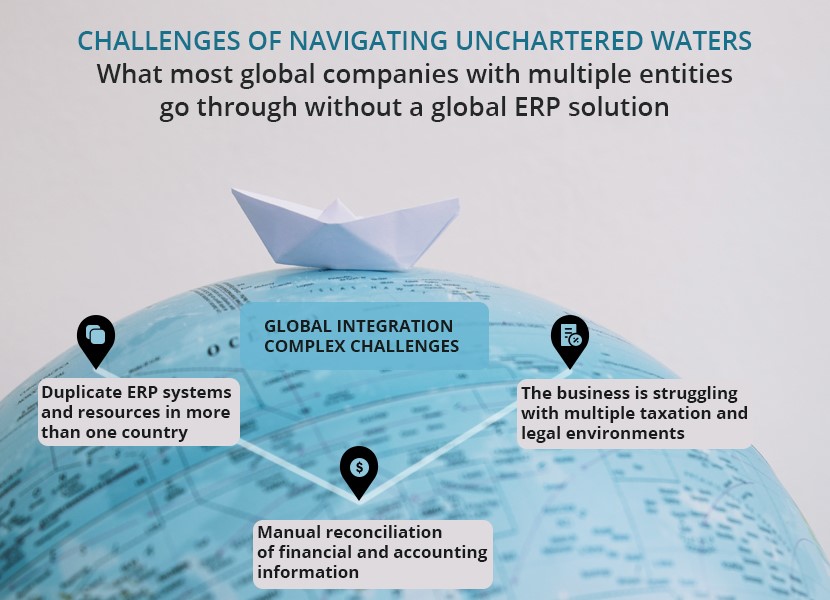
Go big or go home
Most of the manufacturing world has gone global. Access to larger markets drives higher demand for products and as manufacturers grow in size, so does the complexity of running their business. However, the task ahead is not as dire as it may seem, as the ease of accommodating changes to the global business environment has become one of the most important capabilities of ERP software for manufacturing companies of any size.
Enterprise Resource Planning has enabled global companies to overcome several challenges that come with expansion into newer markets such as challenges with global master data harmonization/consolidation, local regulatory and tax compliance, disjointed business processes and disparate system infrastructures to name a few.
You’re either part of the solution or part of the problem
Companies like SAP, Epicor and Microsoft offer their customers a template management approach which allows customers with multi-site installations to efficiently manage their business processes across geographies. This global rollout approach is growing in popularity and I’m here to tell you why.
Organizations that operate globally will find that individual sites tend to operate as individual subsidiaries. It is not uncommon to run into problems when you have ERP solutions running in silos for each entity. Imagine the same function across all entities running differently?
For e.g. accountants at each facility managing accounting data separately and he/she must then manually reconcile this data to create the financial reports which he/she sends to top management. Stay with me! Imagine top management receiving 20-30 separate reports in different formats with different tax and legal structures with information that may or may not be accurate due to manual intervention. This is any organisations worst nightmare. This process is not only time-consuming and risk-prone but also extremely complicated.
The global marketplace
In a happier world there exists a global template approach for global organisations with multiple entities. We are talking standardisation but tailored to the needs of that entity (regional or otherwise). It may sound contradictory but it’s rather simple.
It’s as simple (well not that simple) as creating a centrally developed implementation template with local rollouts. How this works is that we need to create and deploy the solution in one country (or site) and this is then followed by several parallel deployments.
In an idealistic scenario, most ERP vendors would love to go with a pre-defined template. Imagine a template made in wholesale, a one shoe fits all approach. This would probably work with entities in the same region and it is the perfect approach to keep implementation costs low.
But in saying that, we don’t live in an ideal world do we? Customizations (is a dreadful word) are the need of the hour as every organisation believes that they know best and the way they do things is the final word. A flexible template will always be what works in a global scenario. A tailored approach (because we hate the word customization) will always be required to fit in different regulatory frameworks as well as those processes that are unique to that organisation after a harmonisation exercise identifies all commonalities across the enterprise.
For obvious reasons the cost of a flexible template will probably be a bit higher than a pre-defined one but an organisation with multiple entities will benefit greatly from harmonised business processes and visibility of operations across local entities.
Here are some of the benefits:
- A globally adopted system allows organisations to transcend geographical and regional barriers to create standardised and harmonised business processes. Streamlined processes creates best practices which in turn enables better performance and efficiency. It becomes the optimal solution for each company.
- One of the biggest advantages of a global template approach is global visibility. Top management can now see the whole picture and are able to take responsive decisions to mitigate risk and manage compliance as the solution caters to company specific requirements.
- Besides these business advantages, the ability of the IT team to provide ongoing support and enhancements to a single global system is vastly better than when there are multiple disjoint systems
In most cases, organisations are seeking to rationalise and reduce the number of ERP systems they deploy, usually with joint objectives of cost savings and increased efficiency through the extension of common global business processes. The objective here is to benefit from the economies of scale and the reusability of the template package.
A global ERP template approach can help your organization successfully move into new markets while maintaining visibility into overall operations, optimizing value chains, and simplifying IT environments.
Get your Case Study and know more about RheinBrücke’s Global template approach for Global ERP implementations.





